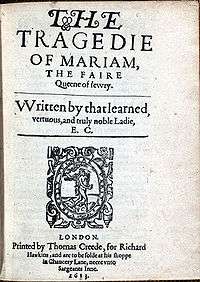The Tragedy of Mariam

The Tragedy of Mariam, the Fair Queen of Jewry is a Jacobean era drama written by Elizabeth Cary, Viscountess Falkland, and first published in 1613. The play is the first work by a woman that was published under her own name. The play received only marginal attention until the 1970s, when feminist scholars recognized the play's contribution to English literature. Since then the play has received a large amount of scholarly attention.
The play was written between 1602 and 1604.[1] It was entered into the Stationers' Register in December 1612. The 1613 quarto was printed by Thomas Creede for the bookseller Richard Hawkins. Cary's drama belongs to the subgenre of the Senecan revenge tragedy. The primary sources for the play are The Wars of the Jews and The Antiquities of the Jews by Josephus, which Cary used in Thomas Lodge's 1602 translation.
Synopsis
The Tragedy tells the story of Mariam, the second wife of Herod the Great, King of Judea from 39 to 4 B.C. When the play opens, in 29 B.C., Herod is thought dead at the hand of Octavian (later Emperor Augustus), and Mariam faces her ambivalent feelings about her husband; Herod had loved her, but had also murdered her grandfather and brother. In Act IV, however, Herod returns, dispelling the false report of his death. Herod's immoral and "villain"[2] sister Salome falsely convinces Herod his wife has been unfaithful in his absence which results in him ordering Mariam's execution. Though Mariam is the title character and the play's moral center, her part in the play amounts to only about 10% of the whole;[3] Cary uses a set of secondary characters to provide a multi-vocal portrayal of Herod's court and Jewish society under his tyranny. The Chorus, in its representation of the patriarchal ideals of femininity, offers an opportunity to interrogate these values, in accordance with the political impetus of the closet drama.[4] The ending of the play is consistent with the tyranny of both its fictional Herod and the actual historical figure: six characters die, including Mariam. The play also explores the themes of divorce and female agency through the characters of both Mariam and Salome.
The play has been edited and published in several modern editions, and has acquired a large and growing body of critical and scholarly commentary.
Performance history
The Tragedy of Mariam was directed by Stephanie Wright for Tinderbox Theatre Co. at the Bradford Alhambra Studio, 19–22 October 1994.
The Tragedy of Mariam, Fair Queen of Jewry was directed by Liz Schafer at the Studio Theatre, Royal Holloway and Bedford New College, October 1995 (two performances).[5]
Mariam was directed by Becs McCutcheon for Primavera at the King's Head Theatre, Islington, 22 July 2007.
The Tragedy of Mariam, Faire Queene of Jewry was directed by John East, 28 June 2012, Central School of Speech and Drama, London.
On 14 March 2013, The Tragedy of Mariam was produced by the Improbable Fictions staged reading series in Tuscaloosa, Alabama.[6] It was directed by Kirstin Bone, produced by Nicholas Helms, and starred Miranda Nobert, Glen Johnson, Deborah Parker, Steve Burch, Michael Witherell, and Lauren Liebe.
The Mariam Project - Youth and Young Girlhood was directed by Becs McCutcheon for Burford Festival 2013, 12 June 2013 at St John the Baptist Church, Burford, Oxfordshire.[7] The designer was Talulah Mason.[8]
Lazarus Theatre Company performed The Tragedy of Mariam at the Tristan Bates Theatre in London's Covent Garden, in a version by director Gavin Harrington-Odedra, 12–17 August 2013.
The Mariam Pop Up installation was at the Gretchen Day Gallery, Peckham South London, 13 August 2013, directed by Rebecca McCutcheon and designed by Talulah Mason.[9]
Notes
- ↑ Cerasano and Wynne-Davies, p. 47.
- ↑ Cerasano, p. 19.
- ↑ Elaine Beilin, in Pacheco, p. 137.
- ↑ Falk, p. 1.
- ↑ This production has been put on YouTube by RoyalHollowayDrama
- ↑ Helms
- ↑ http://rebeccamccutcheon.com/category/the-mariam-project/
- ↑ http://talulahmason.com/the-mariam-project.html
- ↑ http://talulahmason.com/cary-the-mariam-cycles.html
References
- Falkland, Elizabeth. The tragedie of Mariam, the faire queene of Jewry. On-line edition at A Celebration of Women Writers
- Falkland, Elizabeth. The Tragedy of Mariam, the Fair Queen of Jewry. Stephanie Hodgson-Wright, ed. Peterborough, ON, Broadview Press, 2000. ISBN 9781551110431.
- Falkland, Elizabeth. The Tragedy of Mariam, the Fair Queen of Jewry. Barry Weller, Margaret W. Ferguson, eds. Berkeley, University of California Press, 1994.
- Cerasano, Susan P. Readings in Renaissance Women's Drama : Criticism, History, and Performance, 1594-1998. London, Routledge, 1998.
- Cerasano, Susan P., and Marion Wynn-Davies, eds. Renaissance Drama by Women: Texts and Documents. London, Routledge, 2003.
- Falk, Viona (1995). The Chorus in Elizabeth Cary's Tragedy of Mariam (M.A. thesis). Wilfrid Laurier University. External link in
|title=(help) - Helms, Nicholas. "IF presents "The Tragedy of Mariam" this Thursday!".
- Lewalski, Barbara. Writing Women in Jacobean England. Cambridge, MA, Harvard University Press, 1994.
- Pacheco, Anita, ed. A Companion to Early Modern Women's Writing. London, Blackwell, 2002.
- Wray, Ramona, ed. "The Tragedy of Mariam. By Elizabeth Cary." Arden Early Modern Drama. London, Bloomsbury, 2012. ISBN 9781904271598
External links
-
 The Tragedy of Mariam public domain audiobook at LibriVox
The Tragedy of Mariam public domain audiobook at LibriVox